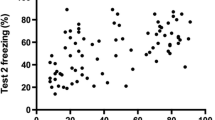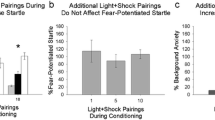Abstract
The fear-potentiated startle (PSR) paradigm is a putative behavioral model for the determination of anxiolytic properties of drugs. The present study further investigated the predictive validity of the model. Predictive validity is high, when only drugs clinically used as anxiolytics attenuate PSR dose dependently. Results showed that startle potentiation decreased dose dependently after the administration of the anxiolytics CDP (2.5–10 mg/kg, IP) and alprazolam (1–3 mg/kg, IP). After administration of the clinically non-anxiolytic drugs amitriptyline (2.5–10 mg/kg, IP), carbamazepine (5–20 mg/kg, IP), fentanyl (0.0025–0.04 mg/kg, SC), naloxone (2.5–10 mg/kg, IP), nicotine (0.4–1.6 mg/kg, IP), alcohol (500–2000 mg/kg, IP), andd-amphetamine (0.6–2.4 mg/kg, IP), a dose-dependent decrease in startle potentiation was not found. The PSR correctly discriminated most of the drugs tested in clinically anxiolytic and clinically non-anxiolytic drugs. However, haloperidol behaved as a false positive, and results of nicotine and alcohol were at variance with results reported by others.
Similar content being viewed by others
References
Berg WK, Davis M (1985) Associative learning modifies startle reflexes at the lateral lemniscus. Behav Neurosci 99:191–199
Cassella JV, Davis M (1985) Fear-enhanced acoustic startle is not attenuated by acute or chronic imipramine treatment in rats. Psychopharmacology 87:278–282
Davis M (1979a) Diazepam and flurazepam: effects on conditioned fear as measured with the potentiated startle paradigm. Psychopharmacology 62:1–7
Davis M (1979b) Morphine and naloxone: effects of conditioned fear as measured with the potentiated startle paradigm. Eur J Pharmacol 54:341–347
Davis M (1986) Pharmacological and anatomical analysis of fear conditioning using the fear-potentiated startle paradigm. Behav Neurosci 100:814–824
Davis M (1992a) The role of the amygdala in fear and anxiety. Annu Rev Neurosci 15:353–375
Davis M (1992b) The role of the amygdala in fear-potentiated startle: implications for animal models of anxiety. Trends Pharmacol Sci 13:35–41
Davis M, Gendelman DS, Tischler MD, Gendelman PM (1982) A primary acoustic startle circuit: lesion and stimulation studies. J Neurosci 6:791–805
Davis M, Cassella JV, Kehne JH (1988) Serotonin does not mediate anxiolytic effects of buspirone in the fear-potentiated startle paradigm: comparison with 8-OH-DPAT and ipsapirone. Psychopharmacology 94:14–20
Halgren E (1992) Emotional neurophysiology of the amygdala within the context of human cognition. In: Agleton JP (ed) The amygdala: neurobiological aspects of emotions, memory, and mental dysfunction. Wiley-Liss, New York, pp 191–229
Hijzen TH, Slangen JL (1989) Effects of midazolam, DMCM and lindane on potentiated startle in the rat. Psychopharmacology 99:362–365
Hitchcock JM, Davis M (1986) Lesions of the amygdala, but not of the cerebellum or red nucleus, block conditioned fear as measured with the potentiated startle paradigm. Behav Neurosci 100:11–22
Hitchcock JM, Davis M (1991) Efferent pathway of the amygdala involved in conditioned fear as measured with the fear-potentiated startle paradigm. Behav Neurosci 105:826–842
Kehne JH, Cassella JV, Davis M (1988) Anxiolytic effects of buspirone and gepirone in the fear-potentiated startle paradigm. Psychopharmacology 94:8–13
LeDoux JE (1987) Emotion. In: Mountcastle VB (ed) Handbook of physiology, Section 1: The nervous system. American Physiological Society, Bethesda, Maryland, pp 419–459
Mansbach RS, Geyer MA (1988) Blockade of potentiated startle responding in rats by 5-hydroxytryptaminelA receptor ligands. Eur J Pharmacol 156:375–383
Rescorla RA (1967) Pavlovian conditioning and its proper control procedures. Psychol Rev 74:71–80
Rosen JB, Davis M (1990) Enhancement of electrically elicited startle by amygdaloid stimulation. Physiol Behav 48:343–349
Rosen JB, Hitchcock JM, Sananes CB, Davis M (1991) A direct projection from the central nucleus of the amygdala to the acoustic startle pathway: anterograde and retrograde tracing studies. Behav Neurosci 105:817–825
Salamone JD (1992) Behavioral pharmacology of dopamine systems: A new synthesis. In: Agleton JP (ed) The amygdala: neurobiological aspects of emotions, memory, and mental dysfunction. Wiley-Liss, New York, pp 599–615
Scheel-Kruger J, Willner P (1991) The mesolimbic system: principles of operation. In: Willner P, Scheel-Kruger J (eds) The mesolimbic dopamine system: from motivation to action. Wiley, New York, pp 559–599
Sorenson CA, Wilkinson LO (1983) Behavioral evidence that nicotine administration has anxiolytic actions. Society for Neurosci Abstr 9:137
Author information
Authors and Affiliations
Rights and permissions
About this article
Cite this article
Hijzen, T.H., Houtzager, S.W.J., Joordens, R.J.E. et al. Predictive validity of the potentiated startle response as a behavioral model for anxiolytic drugs. Psychopharmacology 118, 150–154 (1995). https://doi.org/10.1007/BF02245833
Received:
Revised:
Issue Date:
DOI: https://doi.org/10.1007/BF02245833




